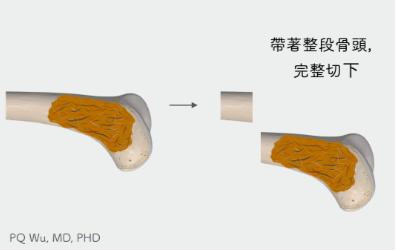
Wide Resection .
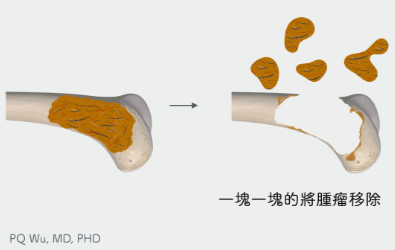
Intralesional Curettage
Most tumors recur for several reasons:
1. The activity (cell division ability) of the tumor itself is strong. Examples include most malignant tumors, benign giant cell tumors, and osteochondromas
2. In addition to the main tumors, small satellite tumors are scattered nearby.
3. After surgery, remaining tumors exist.
Patients, family members, and surgeons are very unwilling to see the tumor remains after surgery. However, surgical removal of tumors sometimes is like cleaning up the debris of breaking glass at home. The surgeon will visually inspect the remaining glass debris, i.e., the tumor, carefully, yet occasionally there will be some omission. Such invisible remaining tumors, if more active, will continue growth and result in tumor recurrence
According to our experiences, we see locations that are more likely to have tumor residues include:
I. On the top of the bone cavity.
During surgery, the physician's vision is from the top. So, the top site indicated by the arrow will not be visible and easy to miss. Hence, we will schedule a specific time to clean the top and scraping each location after the main surgical removal. In addition, we will use the mirrors used by the dentists to view the condition of the cavity top.
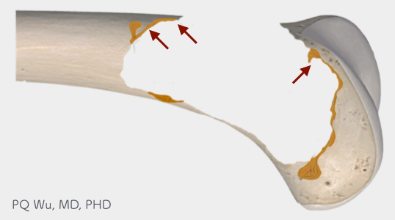
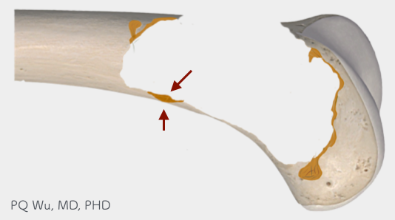
II. Close to the verge of cortical bone breakag
II. Close to the verge of cortical bone breakage
Many highly active tumors can damage the cortical bone and even break out the bone from inside. And these places, doctors will be more conservative and avoid too much scraping because they have concerns on the fractures resulting from the excess use of high-speed burr that causes bone structure damage and may even harm the external nerves and blood vessels.
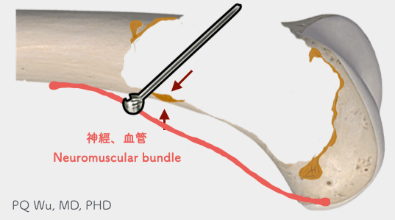
III. Close to the joint surface.
Some common tumors, such as giant cell tumors, grow relatively close to the joint surface. Doctors will be more conservative to avoid the early occurrence of degenerative arthritis because they have concerns on damaging the vascular structures and joint cartilages resulted from the excess use of high-speed burr.
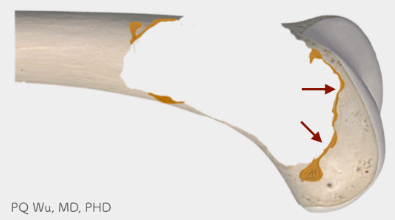
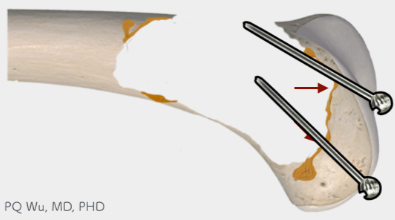
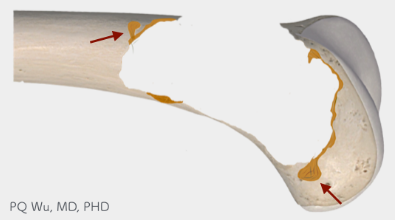
IV. Small tumors not connected to major tumors.
Some tumor areas will be the continuous growth of the original tumor to other bone sites, and these areas are often not easy to spot visually. At this time, we must rely on a good preoperative imaging examination to find it out.
For those 'invisible' or 'known but unable to remove thoroughly’ residual tumors mentioned above, we can use the third step of 'adjuvant therapy' to deal with after the first step of surgical curettage and the second step of high-speed burr removal to reduce the chance of tumor recurrence. Currently, two commonly used methods include phenol combined with alcohol and liquid nitrogen cryotherapy.
Phenol (C6H5OH) is a weak acid with very strong oxidative ability that can denature proteins and destroy DNA. Dr. Lister, who first used phenol in medicine in 1865, used it as a preoperative sanitization for surgical tools to reduce the post-operative infection rate.
During surgery, we can 'apply' phenol to the bone or 'pour' it completely into the bone cavity. By direct contact of phenol with tumor tissue, the residual tumors attached to the bone crevices will be eliminated. After the reaction of phenol, the alcohol is used to neutralize the remaining phenol to avoid persistent normal tissue damage from a long-term reminder of phenol.
For the advantages and disadvantages of phenol, please see the following table:
Phenol
Destroys tumor very effectively.
Phenol has a strong ability to destroy tumor cells. We even treat the tumor cells that were exposed to phenol as 100% dead tumor cells for reference
Inadequate bone penetration
According to a 2013 study by University Hospital Wuerzburg in Germany, the penetration of phenol to bones was only 0.2 mm. Therefore, for tumors hiding deeper in bone crevices, it is not possible to fully show effectiveness.
Uncomfortable odor
Phenol itself has an odor of paste, and the smell lasts for quite a long time. So, if phenol has been used in the morning surgery, the smell will remain in the operating room all day long. It's very uncomfortable for the medical staff.
Irritation
Phenol is irritative to respiratory tracts after long-term exposure. Health care workers may have respiratory damage after long-term inhalation of phenol. In our experience, inhaling too much phenol often causes dizziness.
Hard to purchase
It's hard to purchase phenol, and it’s not cheap. Physicians will not have health insurance or other sources of reimbursement on using phenol; so, it’s always paid out of physician’s pocket.
Chemical use
The phenol currently available is for chemical use, not for medical use. So, the use of phenol in patients in the past may be possibly illegal now.

70% to 80% of pheno
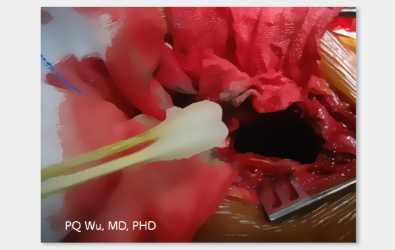
Use cotton swabs to coat the entire bone cavity with pheno
What will surgeons do if the past commonly used phenol has many defects and is prohibited? Will they just wait for the tumors to recur?
Fortunately, we still have cryotherapy- a classical, elegant, and mysterious technology!
For the application, principles, and history of cryotherapy, please continue to the following articles.


